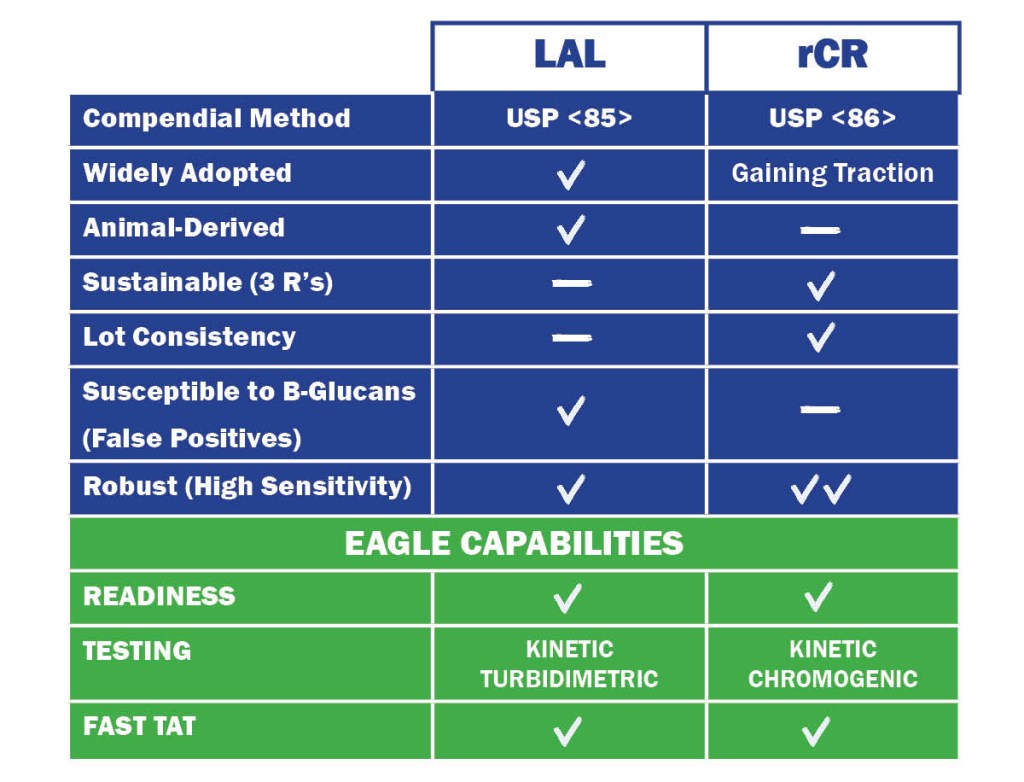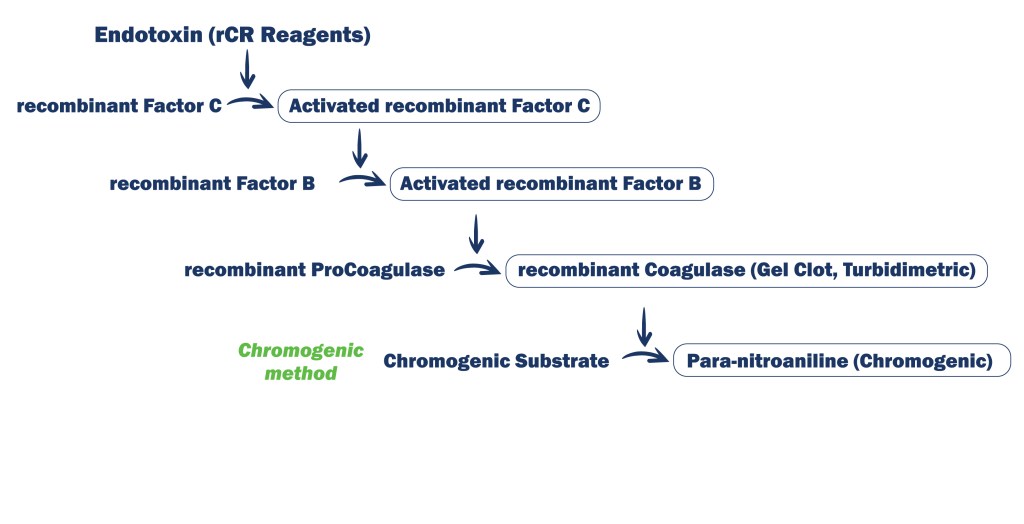Ensuring Safety Through USP
Bacterial endotoxins pose serious health risks, particularly when introduced into sterile environments such as the bloodstream or spinal fluid. To mitigate these risks, the United States Pharmacopeia (USP) mandates endotoxin testing for sterile injectable products. Specifically, USP <85> outlines the acceptable endotoxin limits and provides standardized methods for detection and quantification of endotoxins derived from Gram-negative bacteria.
During method validation, it is essential to demonstrate that the product formulation does not interfere with the test and that the chosen method is sufficiently sensitive and accurate. This ensures the reliability of the results and confirms that endotoxin levels remain within safe thresholds, thereby safeguarding patient health and supporting regulatory compliance.
A bacterial endotoxins test can be conducted using the traditional Limulus Amebocyte Lysate (LAL) method described in USP <85>, or alternatively, by employing recombinant methods such as those utilizing recombinant Factor C (rFC) or recombinant cascade reagents (rCR), as outlined in USP <86>.
What are Endotoxins?
Bacterial endotoxins, integral components of the outer membrane of Gram-negative bacteria, belong to a class of complex phospholipids known as lipopolysaccharides (LPS). These endotoxins are typically released into the surrounding environment when bacterial cells undergo lysis or structural disruption. Notable genera of Gram-negative bacteria that produce endotoxins include Escherichia, Salmonella, Shigella, Pseudomonas, and Haemophilus. The presence of endotoxins is clinically significant due to their potent immunostimulatory effects, which can trigger inflammatory responses and septic shock in humans.
Why Test for Endotoxins?
Endotoxin testing is critical for ensuring patient safety in pharmaceutical and medical device manufacturing. Endotoxins can trigger severe immune responses, including fever, inflammation, septic shock, and even death. Because of these risks, it is essential to test products that come into direct contact with the bloodstream or spinal fluid, such as injectables, active pharmaceutical ingredients (APIs), excipients, raw materials, medical devices, process water, etc. Routine endotoxin testing helps prevent contamination, supports regulatory compliance, and ultimately protects human and animal health.
Whether you want <85> or want to <86> it … We’ve got your number!
Methods for detecting bacterial endotoxins have evolved significantly since the late 19th century. Numerous options and technologies are available on the market, compliant with regulatory standards and practices. At Eagle, we keep pace with changes in the industry and stay current with new technologies.
For bacterial endotoxin analysis, we perform 2 types of testing, offering equally exceptional service and quality for both tests:
- Traditional USP <85> using LAL (Limulus Amoebocyte Lysate) and the turbidimetric method, which is based on the development of turbidity after cleavage of an endogenous substrate.
- USP <86> using rCR reagents.

USP <85> Bacterial Endotoxins test.
This test detects or quantifies endotoxins from Gram-negative bacteria using amoebocyte lysate from horseshoe crabs. It can be performed by three techniques: gel-clot (gel formation), turbidimetric (turbidity development), and chromogenic (color development).

Turbidimetric Method – Test principle
- The LAL reagent is combined with the test sample under specified conditions.
- In the presence of endotoxins, the reaction mixture develops turbidity due to the formation of an insoluble coagulin clot precursor.
- The rate of turbidity development is monitored continuously or at defined intervals using a calibrated spectrophotometer at the prescribed wavelength
- Endotoxin concentrations are determined by comparing the reaction kinetics of the test sample to those of a reference standard endotoxin calibration curve.
Chromogenic Method – Test principle
- The reaction principle mirrors the turbidimetric method but incorporates a chromogenic substrate within the LAL reagent.
- In the presence of endotoxins, the enzymatic cascade releases a chromophore from the substrate, producing a measurable color change.
- The rate or intensity of color development is quantified spectrophotometrically at the appropriate wavelength (typically 405 nm).
- Endotoxin concentrations are calculated by comparing the test sample’s colorimetric response to a reference standard endotoxin calibration curve.
Gel-clot Method – Test principle
- The LAL reagent is combined with the test sample under controlled conditions.
- The mixture is incubated at 37 ± 1°C for 60 ± 2 minutes as specified in the compendial method.
- After incubation, the reaction vessel is gently inverted to assess gel formation:
- Positive result (endotoxins present): a firm, intact gel forms and remains in place upon inversion.
- Negative result (no endotoxins detected): the mixture remains fluid and flows freely.
USP <86> Bacterial Endotoxins Test Using Recombinant Reagents.
USP <86> outlines animal-free methods for detecting endotoxins from Gram-negative bacteria using recombinant reagents. These include recombinant Factor C (rFC) and recombinant Cascade Reagent (rCR), which utilize one or more proteins cloned from the horseshoe crab’s natural clotting cascade. These sustainable alternatives offer reliable endotoxin detection without relying on animal-derived materials.
rCR (Recombinant Cascade Reagent) – Test principle
The rCR assay functions similarly to the chromogenic LAL test, but without using horseshoe crab blood. It replicates the enzymatic clotting cascade through recombinant proteins, producing a measurable color change. The rate of this reaction correlates with endotoxin concentration—the faster the color develops, the higher the endotoxin level.

rFC (Recombinant Factor C) – Test principle
The rFC method uses only recombinant Factor C, the first enzyme in the horseshoe crab’s natural clotting cascade. Upon endotoxin activation, a fluorimeter detects fluorescence from a synthetic peptide-fluorophore complex. The faster the fluorescence appears, the higher the endotoxin concentration—indicating a stronger reaction. The rFC method uses only the first step of the LAL enzymatic cascade: Factor C.

Key differences between LAL and recombinant reagents.
LAL – Derived from horseshoe crab blood, LAL is the traditional gold standard for endotoxin detection. It relies on the natural clotting cascade involving Factor C, Factor B, and proclotting enzyme, but is susceptible to interference from (1→3)-β-D-glucans, which can cause false positives.
rFC – A first-generation recombinant reagent that uses only recombinant Factor C from the horseshoe crab’s clotting cascade. It operates via a simplified, single-step fluorescence-based reaction and is not affected by β-glucans, reducing the risk of false positives.
rCR – A second-generation recombinant method that mimics the full LAL enzymatic cascade using genetically engineered proteins. It offers high sensitivity and specificity, is resistant to glucan interference, and is ideal for complex formulations requiring precise endotoxin quantification.
Please keep in mind!
A preparation that passes a sterility test is not necessarily guaranteed to be free of endotoxins. Due to the potential effects on human and animal health, it is essential to make sure that your product is endotoxin-free through the USP <85> Bacterial Endotoxins Test or USP <86> Bacterial Endotoxins Test using Recombinant Reagents.

Get Started Today
Require Assistance?
Call the Eagle Client Care Team at (800) 745-8916 to discuss your operation’s specific needs.
